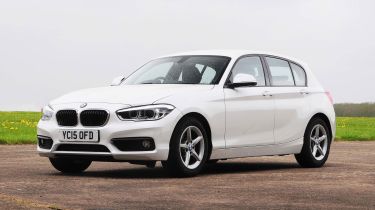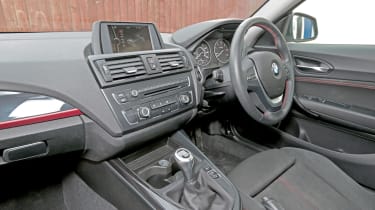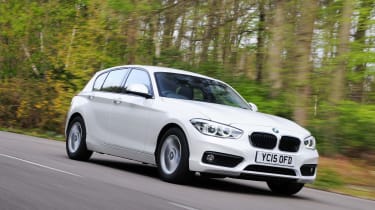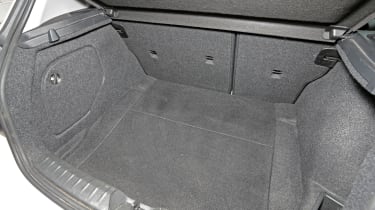Used BMW 1 Series (Mk2, 2011-2019) review
The Mk2 BMW 1 Series is not the roomiest small hatchback, but fun handling and efficient running make up for it
Verdict
As the only rear-wheel-drive model in the segment, this version of the 1 Series is great to drive. It’s also safe, beautifully built and comes with a big choice of efficient engines, so you’re not sacrificing performance in the quest for economy. It was a sales hit when new, though, so not very exclusive. Despite its ubiquity, the 1 Series isn’t the greatest bargain around because it was comparatively expensive when new, while steep running costs mean this isn’t a car to buy if you’re on a budget. The 1 Series is a premium product and while it’s not the best value in this class, there’s still plenty to like about it.
Which one should I buy?
- Best BMW 1 Series for low costs: 118i SE 5dr
- Best BMW 1 Series for fuel economy: 116d SE 5dr
- Best BMW 1 Series for performance: M135i xDrive 5dr Step Auto
The 1 Series is the smallest conventional car BMW makes. It has been around since 2004, and has consistently delivered the kind of fun handling we're used to from BMW, courtesy of its rear-wheel-drive layout. This second-generation hatchback (known in-house as the F20, with three doors, and the F21, with five doors) was introduced in 2011, and while the 1 Series used to be offered in four body styles, the coupe and cabriolet versions were hived off to create the BMW 2 Series range. The F20 and F21 were replaced by the F40 series in 2019.
Used - available now

2020 BMW
1 Series
18,602 milesAutomaticPetrol1.5L
Cash £19,400
2024 BMW
1 Series
33,530 milesManualPetrol1.5L
Cash £19,287
2024 BMW
1 Series
37,839 milesAutomaticPetrol1.5L
Cash £19,506
2021 BMW
1 Series
37,406 milesManualDiesel1.5L
Cash £16,087There are plenty of versions to choose from, with SE, Sport and M Sport trim levels making up the core of the range, plus a variety of economical or hugely powerful engines. As is tradition with BMW, different model numbers signify different engines, although some are simply different power outputs of the same unit.
The entry point to the range is the 134bhp 118i three-cylinder turbo petrol, while other petrol cars include the 181bhp 120i four-cylinder turbo and M140i hot hatchback, which has a 335bhp 3.0-litre straight-six and twin turbos. For diesels, there are 116d (1.5-litre three-cylinder engine with 114bhp), 118d and 120d versions. The latter use the same 2.0-litre four-cylinder unit but with 141bhp and 188bhp respectively. A faster 125d with twin turbos and up to 221bhp was also offered.
All cars come with a six-speed manual gearbox or optional eight-speed auto, except for the M140i, which has a seven-speed auto as standard. And while rear-wheel drive is the order of the day for the whole range, there is the option of xDrive four-wheel drive on the 120d auto.
Overall, the BMW 1 Series is a tempting choice. It appeals to driving enthusiasts thanks to its sporty handling – especially since its 2019 replacement has front- or four-wheel drive only – while BMW's quest for efficiency means all models, even the fastest M140i versions, are relatively economical to run. Passenger space is pretty good considering its sporty pretensions, although it’s not quite the best in class.
What are the alternatives?
The Audi A3 was the first model in the premium small hatch sector and it’s the 1 Series’ biggest rival, thanks to a range of versions, smart styling and excellent cabin – but it’s not as good to drive.
You could say something similar about the VW Golf, which is closely related to the Audi, but unlike the A3, doesn’t come with a four-wheel-drive option in regular hatchback form (you have to opt for the high-performance Golf R to get that). The third-generation Mercedes A-Class is more mainstream than its predecessors, has sold in bigger numbers and is better to drive. Volvo’s V40 is also worth a look, as is the Ford Focus – the latter is cheaper to buy and is great to drive.
BMW 1 Series vs VW Golf and Mazda 3

In this test we asked if the BMW 116d ED was the best compact hatch for family and business users. The VW Golf and Mazda 3 put up a good fight, but the BMW 1 Series emerged victorious, thanks to its efficient engine, dynamics and long list of equipment. Read the full test...
SEAT Leon vs BMW 1 Series
The SEAT Leon was the new kid on the block in 2013, as the Spanish five-door hatchback tried to muscle in on a market dominated by the Germans. For all its strengths, the BMW 1 Series had to settle for second place. Read the full test...
How much will a used BMW 1 Series cost?
The combination of the BMW badge and the rear-wheel-drive dynamics, unique in this segment, means you’ll pay a premium for a 1 Series on the used car market. It’s not all bad news, because many of the expensive optional extras add little to nothing to the price of a used 1 Series, so your budget should stretch further than you think.
Prices
Early examples are now available for as little as £3,000, but you’ll need to increase the budget to £7,000 to secure a post-2015 facelifted BMW 1 Series. Affordable finance when the cars were new meant that many people decided to upgrade from the entry-level SE to the Sport and M Sport models. This means they are more common on the used car market, so you can afford to be picky.
Fuel economy and emissions
The 1 Series is BMW's entry-level model, so it isn't surprising that it's one of the cheapest cars in the range to run after the headline-grabbing electric i3. The 116d is incredibly efficient, although the on-paper figures changed slightly under the more realistic WLTP test procedure. Under the old NEDC cycle, it returned 83.1mpg and 89g/km of CO2 (so cars registered before 1 April 2017 qualify for free road tax). But the WLTP figure is 53.3mpg, with emissions of 111g/km on the smallest wheels.
Engine stop-start technology is standard across the 1 Series range, but we'd suggest sticking with the diesel models if out-and-out fuel economy is a priority. They offer a great balance of performance and value. To help keep fuel use down, all 1 Series models get an Eco Pro mode that encourages more economical driving by reducing throttle response and the amount of load put on the engine by equipment such as air-con.
If you prefer the character of a petrol engine, or you do especially low mileage, the 118i petrol engine returns up to 38.7mpg on the WLTP test and emits 136g/km of CO2, which is very impressive given its performance. Overall, the diesels stack up much better in the consumption stakes. The 118d returns 52.3mpg, while the 120d manages up to 49.6mpg. Emissions for these two are 115g/km and 120g/km respectively, although bigger wheels harm those figures.
The 120i is, as you’d expect, less efficient than the equivalent diesel, but it's still not too bad given the performance on offer. It returns up to 37.2mpg, which means late 30s in reality, while the 32.5mpg M140i isn’t a car to choose if efficiency is your priority. With all of these models, choosing the five-door over the three-door doesn't have an impact on efficiency.
Running costs
BMW offered a range of cost-effective fixed-price servicing and competitive finance deals when the 1 Series was new, to help keep long-term running costs down. Insurance groups begin at 15 for the 116d, which is very low for something with a BMW badge on the front – and the group 18 118i looks similarly good value, given the performance.
Naturally, moving up the range means bigger costs because of the desirability, higher performance and rear-wheel-drive chassis, which can prove more troublesome for less experienced drivers in more powerful versions. The 120d sits in group 24 and the M140i is in group 37 – by comparison, the 296bhp, four-wheel-drive VW Golf R is group 29.
What do owners think?
The 1 Series finished 41st in our Driver Power 2017 satisfaction survey, which isn’t bad for a six-year-old car. Then it finished 46th out of 75 in our 2021 survey. A respectable performance for an ageing family hatchback.
Reliability
BMW finished a disappointing 21st out of 29 brands in the Driver Power 2021 manufacturer’s survey, with a score of 85.29 per cent. All of the Japanese and Korean manufacturers finished ahead of BMW, although Land Rover and Audi were ranked lower.
How practical is it?
The original 1 Series was heavily criticised for its lack of practicality and for prioritising style over substance. The second-generation model, however, is larger – resulting in improved room for rear passengers, better boot space and some useful storage throughout.
A detail worth mentioning is that many versions of the 1 Series feature a dark headlining, which is a blessing and a curse – it makes the interior feel sportier, but also a little more claustrophobic. It's not as spacious inside as a VW Golf or SEAT Leon, but storage places in the cabin include a big compartment beneath the central armrest, deep door bins and a large glove box.
Dimensions, cabin and boot space
A little longer than the five-door Audi A3 Sportback, although not quite as wide or tall, the BMW 1 Series nonetheless fits the convention for a family hatchback; on the road the 1 Series feels roughly the same size as any rival you care to name – Vauxhall Astra, Ford Focus, Lexus CT. That makes it easy to place, and despite a low-set seating position, all-round visibility is good.
The main casualty of the 1 Series’ rear-wheel-drive setup is rear passenger space, and especially the middle seat. The 1 Series has a trio of three-point seatbelts in the rear, but there’s scant legroom in the middle where the transmission tunnel runs.
Headroom is fine for adults front and back, as is rear knee room, with the 1 Series featuring quite thin front seatbacks. There are Isofix points for child seats on the two outer rear seats, and there’s enough space for a rear-facing child seat without having to push the front chairs too far forward.
With the back seats in place, boot space increased by 30 litres on the old 1 Series, to 360 litres, rising to 1,200 litres with the rear bench down – both figures are 20 litres down on that of the Audi A3 Sportback, for example. Frustratingly, BMW consigns a useful 40:20:40 split-folding rear bench to the cost options list for all specifications, so check the car you’re looking at has that.
The 1 Series has a relatively small boot opening, and the floor can’t be lifted flush with the loading lip, which can make unloading awkward. An optional Extended Storage pack adds nets to the boot, usefully keeping smaller items from rolling around.
Equipment and technology
The BMW 1 Series has always been well equipped, but it’s worth hunting for a post-2015 model. Along with revised styling, the facelifted 1 Series also got an improved infotainment system and a new range of more efficient engines. A new eight-speed automatic transmission was also introduced to further aid fuel efficiency. All post-2015 cars also get single-zone climate control as standard.
Taking a 2016 1 Series as an example, the entry-level SE trim level should be more than adequate for most buyers. Highlights include 16-inch five-spoke alloy wheels, rain-sensing wipers and automatic headlights. That said, you can see why so many people decided to upgrade to the more stylish 1 Series Sport.
The 17-inch alloy wheels on Sport do a better job of filling the arches, while the black exterior accents give the 1 Series a more purposeful look. Inside, it has ambient lighting, a choice of driving modes, sport seats, an instrument cluster with red highlights and a multifunction steering wheel with red stitching.
Just as popular was the 1 Series M Sport, which offered the styling of the M140i without the expense or running costs. Highlights include 18-inch alloy wheels, LED headlights, M Sport suspension, the M styling pack and a suite of M Sport interior upgrades. Look out for models with the desirable M Sport Plus package, because these cars get a Harman/Kardon audio upgrade, M Sport brakes and sun protection.
The performance M140i was more a standalone model than a trim level. In addition to the thunderous 3.0-litre six-cylinder engine, these cars have 18-inch alloy wheels with performance tyres, suspension lowered by 10mm, revised damper and suspension settings, dual exhaust pipes and a suite of upgrades unique to the M140i model.
Safety
The 1 Series was awarded the maximum five-star rating in the Euro NCAP crash safety tests, ranking it among the best in class for crash protection. Its 91 per cent adult occupant and 83 per cent child occupant ratings are especially reassuring for family buyers.
These were no doubt aided by the generous amount of standard safety equipment, including a clever five-stage traction control system, four airbags and a raft of safety accessory options such as lane departure warning and low-speed automatic braking.
What’s it like to drive?
As the only rear-wheel-drive car in its class, the BMW 1 Series is nicer to drive than most of its rivals. Even an entry-level model is more engaging than an equivalent front-wheel-drive family hatchback, offering a delightful blend of sharp handling and steering that’s full of feel.
Engines and performance
The petrol range begins with the 118i, which uses a 134bhp 1.5-litre petrol turbocharged three-cylinder engine also found in the MINI. The 120i and 125i share a 2.0-litre unit and the M140i uses a twin-turbo 3.0-litre straight six engine with 335bhp. The 116i was dropped with the 2015 facelift and the M135i became the M140i in 2016.
The update also added a three-cylinder diesel to the 1 Series range, namely the 115bhp 1.5-litre unit also found in the MINI Cooper D and badged 116d here. The 118d, 120d and 125d models stick with a larger four-cylinder 2.0-litre diesel engine, tuned for different power outputs.
Even the 118i will do 0-62mph in 8.5 seconds and hit a top speed of 130mph, while the 120i covers the sprint in 7.4 seconds, the 125i in 6.4 seconds and the M140i in 4.6 seconds. These are all quick cars, and although the M140i sounds the best, on account of its six cylinders, the remaining four-cylinder engines have a smooth thrum all the way to the red line. None of them ever feels breathless if you’re in the right gear.
Around town, the higher-end four-cylinder diesel models – the 120d and 125d – feel quick and eager. That’s because they have 400Nm and 450Nm of torque respectively – the latter only a little less than the M140i, and available as an automatic only.
Arguably the most impressive engine overall is the 116d. With only three cylinders, it manages to haul the 1 Series along nicely, and although it’s not the most eager to rev, its 270Nm of torque is 50Nm more than in the 118i, so it’s a flexible motor.
It sounds pleasant enough too, with BMW having muted most of the diesel clatter. Given that it’s a three-cylinder diesel it’s remarkably smooth, both at idle and full tilt.
On the road
An enjoyable driving experience is one of the biggest selling points of the BMW 1 Series, with every version providing the sort of rear-wheel-drive balance that the competition can only dream of. However, it's no one-trick pony.
The 1 Series doesn’t come cheap, but the good news is that sharp responses and composed cornering are a given all the way through the range, from the 116d to the M140i. All 1 Series models corner without much body roll and show impressive agility, while cars with the optional adaptive dampers ride more comfortably than the equivalent Audi A3 and Mercedes A-Class.
As usual with a BMW, comfort deteriorates the further up the range you go, with an SE car on smaller wheels and with thicker tyre sidewalls providing a noticeably smoother ride than an M Sport car. That’s because M Sport brings with it firmer, lowered suspension, bigger wheels and lower-profile tyres as standard.
For the same reason the seats make a difference too, with an SE’s flatter chairs offering less lateral support but generally being more comfortable over long distances than the tighter sports seats of a Sport or M Sport model.
A six-speed manual gearbox is standard, although all models can be specified with an eight-speed automatic. The 120d is available with xDrive four-wheel drive for added traction, but this increases the car’s weight.
The manual gearbox feels solid, if a little notchy, while the automatic is brilliant – smooth and quick shifting. The eight ratios of the auto mean it stays in the engine’s sweet spot more of the time.
All 1 Series models are quick, with even the cheapest 118i petrol dishing up the sort of 0-62mph sprint that’s firmly in the warm hatch league, and while the 116d might look comparatively sluggish on paper, its strong low-end torque makes it feel flexible in real life.
The 1 Series’ dynamic ability means it’s better suited to petrol engines generally, the high-revving character of these units adding to the driving enjoyment. That said, the very popular 118d and 120d models are positively rapid around town, owing to masses of low-rev torque, while the 125d is a true high-performance diesel. This range-topping engine gives a fantastic blend of real-world pace and 60mpg-plus economy. It’s expensive to buy used, though.
Moving up to the flagship M140i, it has one of the great six-cylinder engines, with a clever two-stage turbocharger which means its peak torque comes in at a ridiculously low 1,300rpm. It also differs from the rest of the range by having a seven-speed auto as standard.
What should you look out for?
The BMW 1 Series Mk2 was a favourite within fleet circles, so servicing and maintenance should have been taken care of on time during the first few years of the car’s life. Beyond that, it’s worth finding a car with full BMW service history because there are plenty of cars to choose from. Diesel versions are likely to have spent a lot of time on Britain’s motorways, so stone chips on the bonnet and front bumper are to be expected. Also look out for kerb damage on the larger alloy wheels.
Common used BMW 1 Series problems
Leaf blockage
Check for leaves blocking the drains in the bulkhead; once a blockage occurs, water is likely to get into the electrics, causing damage.
Misty lights
The headlights are prone to misting up, but they’re ventilated so any moisture behind the glass should find its way out, eventually.
Door rattles
The front doors can rattle. Lubricating the door seals can help, but usually a visit to the dealer for a strip down is the only solution.
Suspension
Several 1 Series models have suffered from knocking noises from the rear suspension because of faulty dampers and/or mounting bushes.
Interior
The design is sober, although the solid build and dash clarity are beyond reproach – especially on cars with the iDrive infotainment system. Rear-seat space is a little tight and shallow windows harm visibility but boot capacity (360 litres with the seats up and 1,200 litres if they’re folded) is okay.
Recalls
The 1 Series Mk2 has been recalled nine times. The first was in July 2013; cars built between February and June could suffer a loss of drive because of clutch failure.
In June 2015, models made between September 2013 and March 2015 were recalled to remedy a fuel pump failure, with the car either not starting or cutting out. The next recall was in December 2016, for examples made up to December 2015 that could suffer electric power steering failure.
Other recalls in 2017 and 2018 covered issues regarding the driveshaft, the electrics, a seat backrest and exhaust gas recirculation module.











